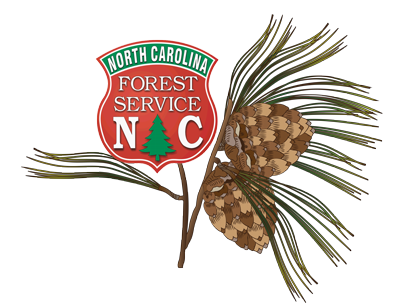 Clemmons Educational State Forest
Clemmons Educational State Forest Clemmons Educational State Forest
Clemmons Educational State ForestClemmons Educational State Forest
2411 Old U.S. 70 West
Clayton, N.C. 27520
Phone: 919-553-5651
ClemmonsESF.ncfs@ncagr.gov

Amid the trees and undergrowth of Clemmons Educational State Forest lurk clues to the land's past. Old Longleaf pine stumps bear the scars of a practice known as "boxing" - a method of collecting sap for use in the construction of wooden ships.
The naval construction industry thrived in North Carolina thanks to the Longleaf pine. Longleaf pine once dominated the eastern North Carolina landscape. From the Colonial period until the end of the 19th century sap from the trees was used to make resin, pitch, turpentine, and tar, for sealing the hulls of wooden boats and ships. Clemmons' proximity to the town of Smithfield, sitting astride the Neuse river, meant that supplies of these products could be easily transported to coastal ship-building communities.
In other places on the forest, faint furrows can still be seen, testimony to the farming practiced in the early 20th century. Eventually, soil erosion ended the farming, and in the 1930's, the Civilian Conservation Corp moved onto the land and constructed a nursery, which was eventually turned over to the N.C. Forest Service. As time passed, a mixture of pine and hardwoods grew to dominate a landscape that had once been a Longleaf pine savannah - a fairly open stand of trees on ground covered with warm season grasses.

The staff of Clemmons is currently working to restore the original Longleaf stands on scattered areas of the forest which total some 150 acres. When completed, the Longleaf pine will make up approximately one half of all trees on the land and cover around 400 acres of land.
To achieve this goal, the staff is using a technique known as "uneven-aged management" which helps maintain a more natural appearance in affected areas. Specific trees are chosen for harvesting in order to give the Longleaf the room it needs to become established.
A significant amount of space is needed to properly grow the Longleaf. It requires a great deal of direct sunlight, and is also dependant on fire in order to thrive. The thick bark of the tree is resistant to the low intensity wildfires which once occurred periodically in the area. Competing species, which lack the Longleaf's protection, are thus disposed of, providing needed room for the pine. The rangers at Clemmons use prescribed burns to mimic the role of natural fires.
The ecosystem established by the restoration will not only recreate the original look of the area, it will also be a boon to native wildlife that depend upon open habitats and Longleaf pine seed as a forage item.
The full benefits of the restoration won't be seen for many years, but the reward for the staff at Clemmons is the knowledge that their children, and the children of others, will.
Questions or comments about this site? Contact the webmaster